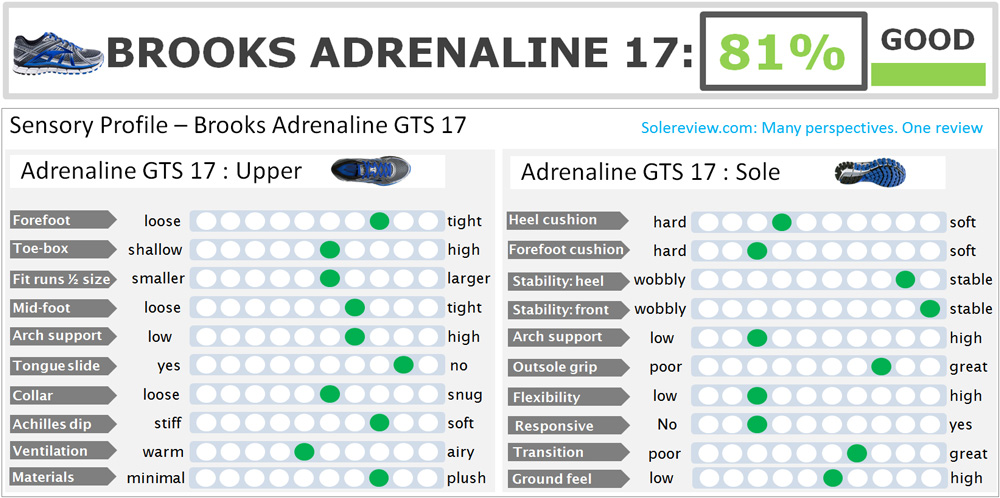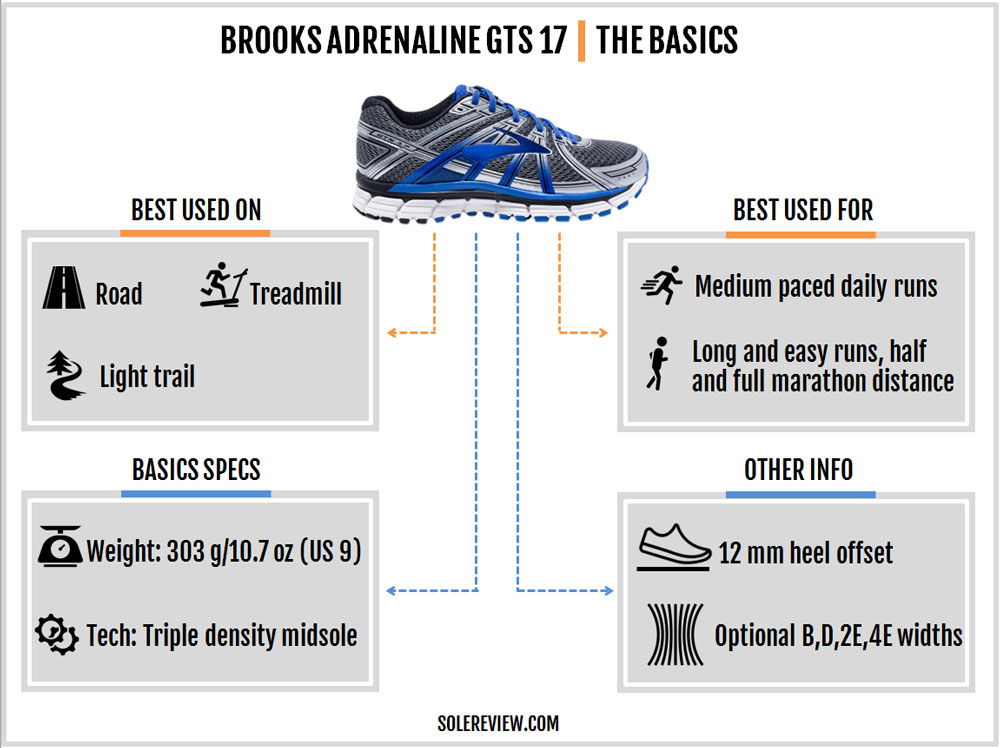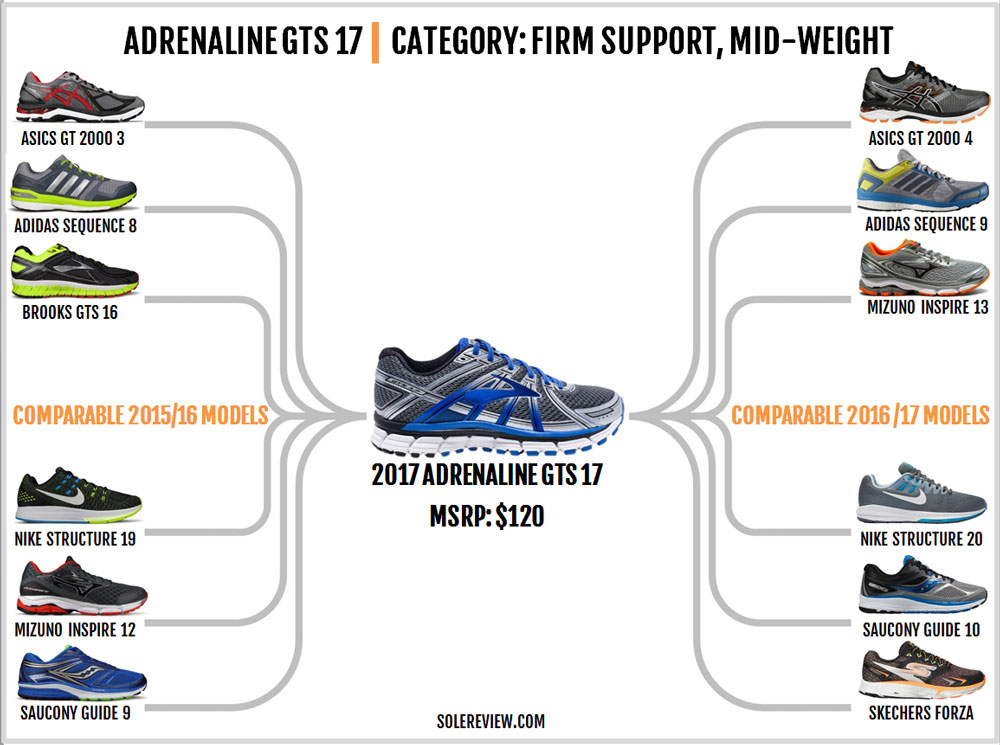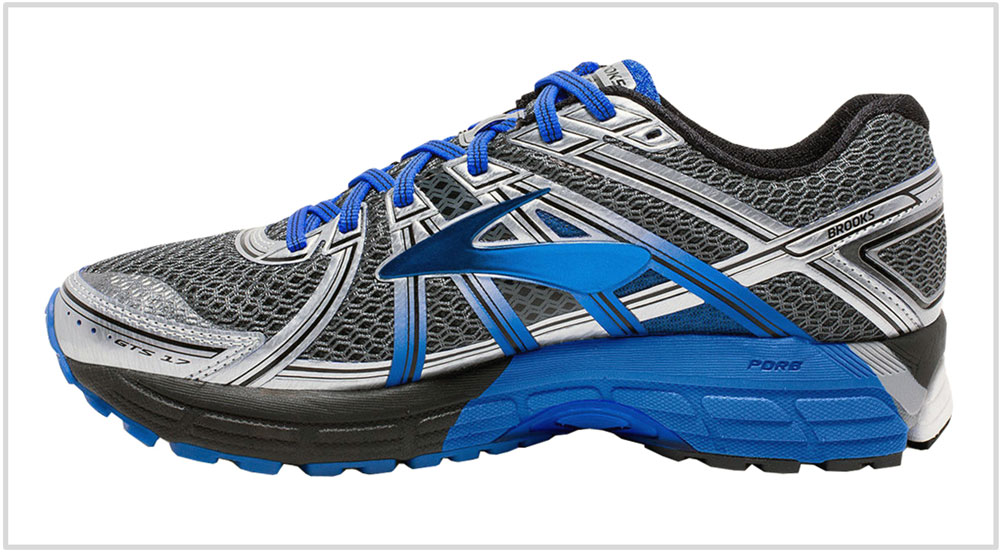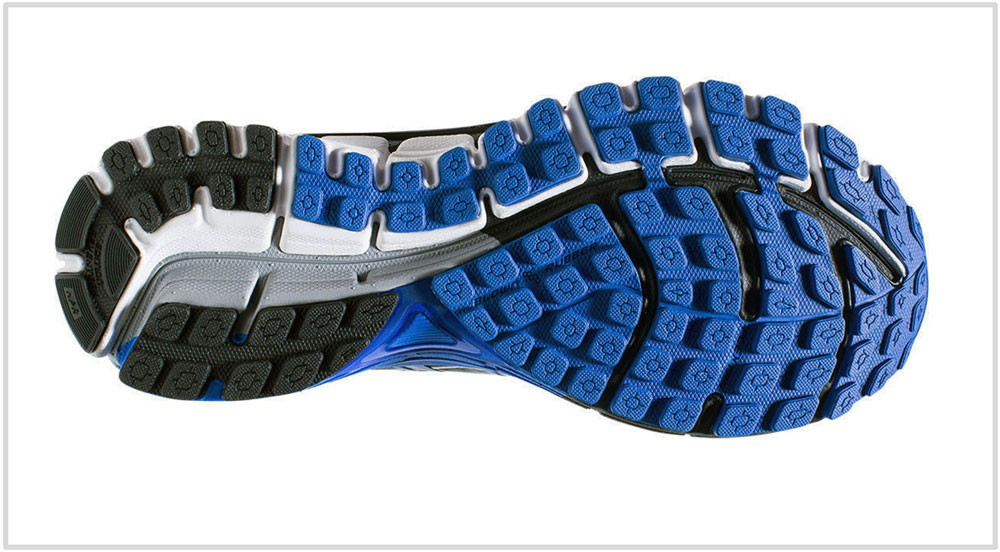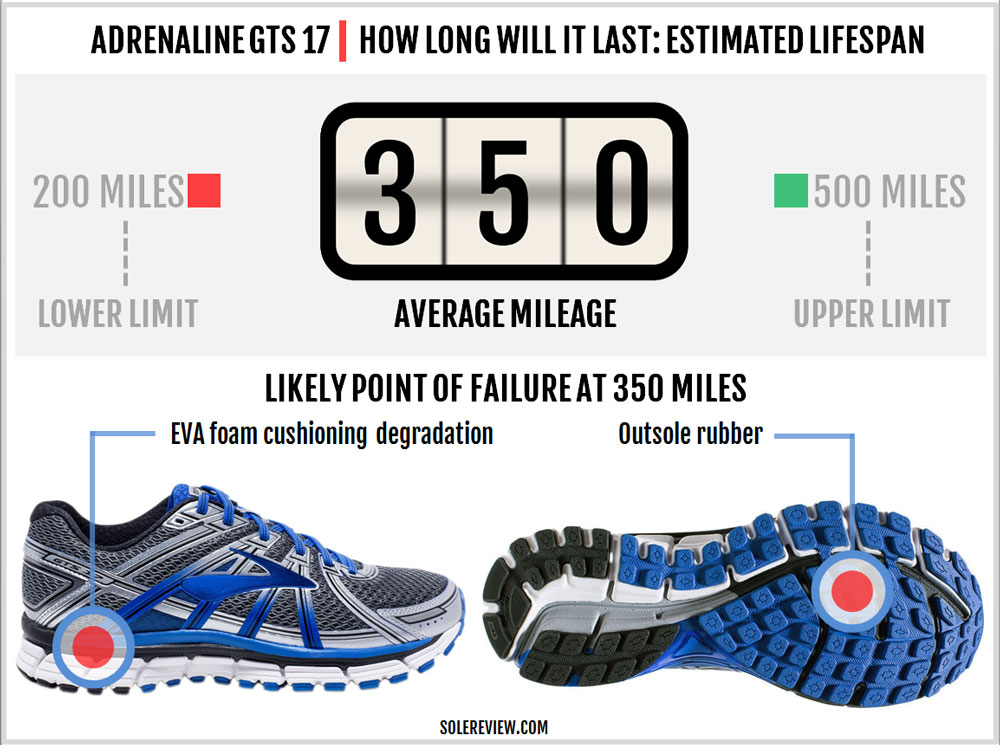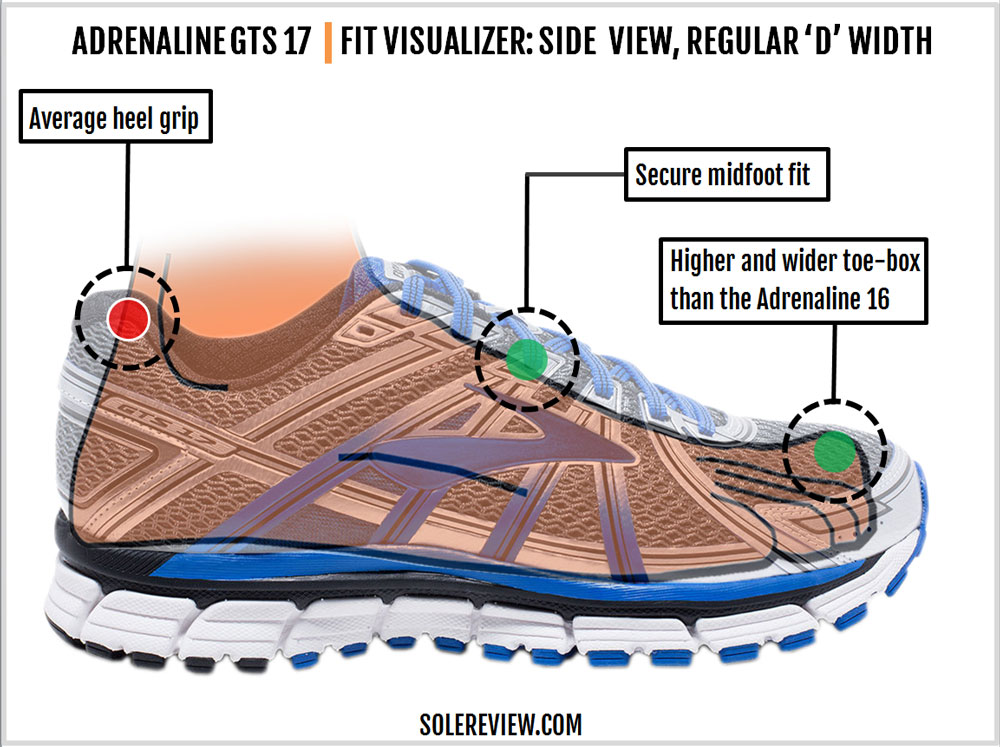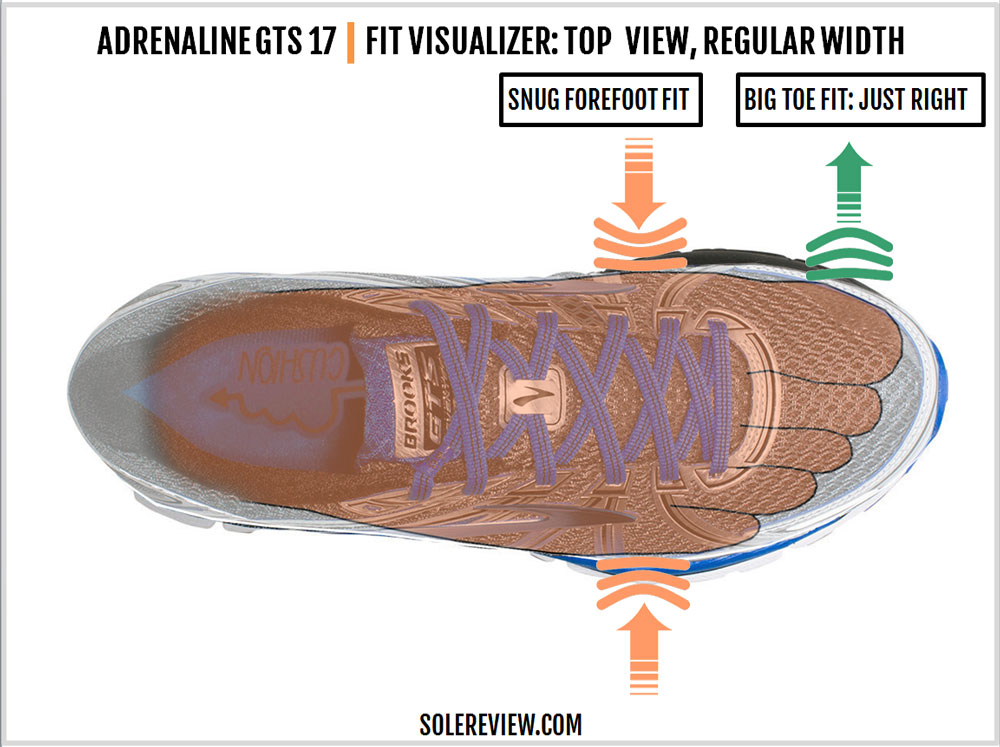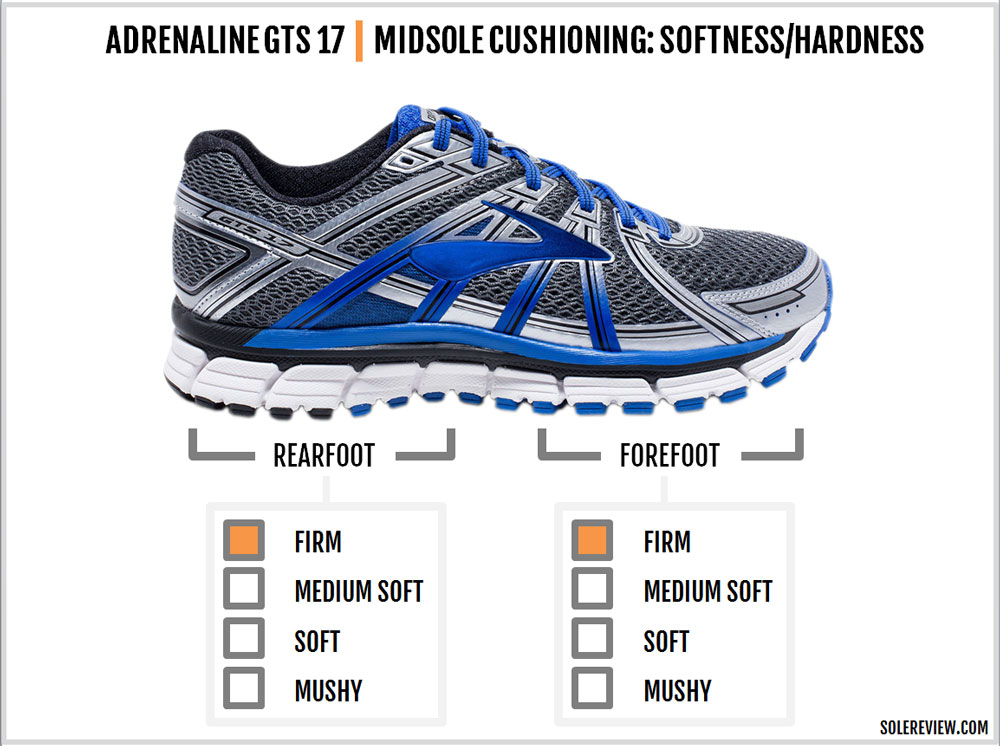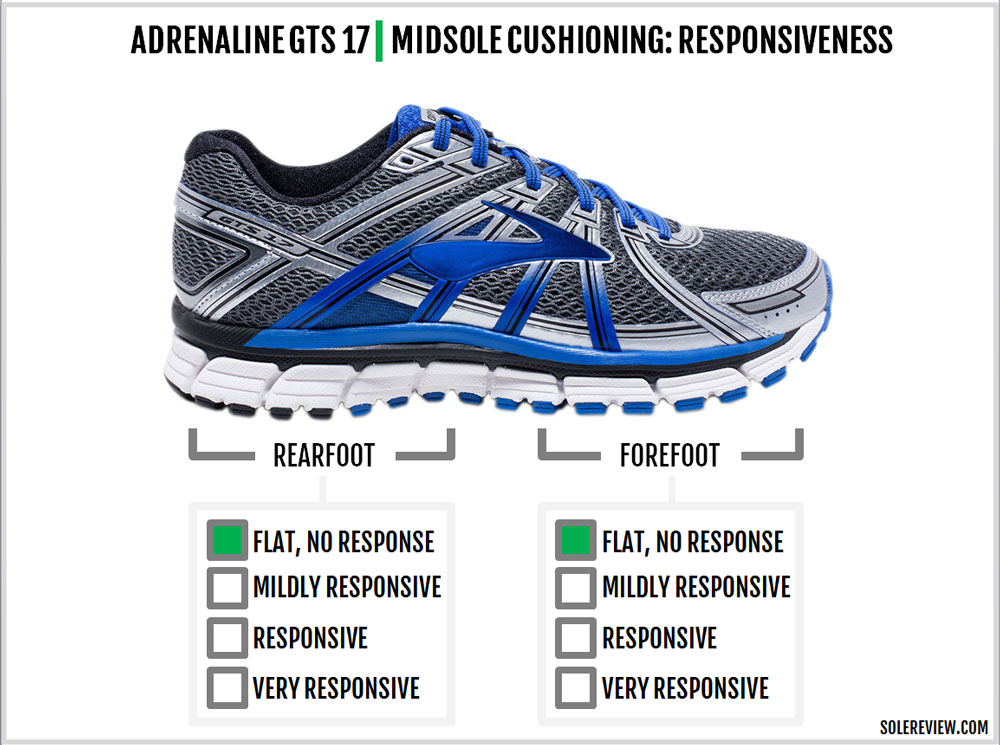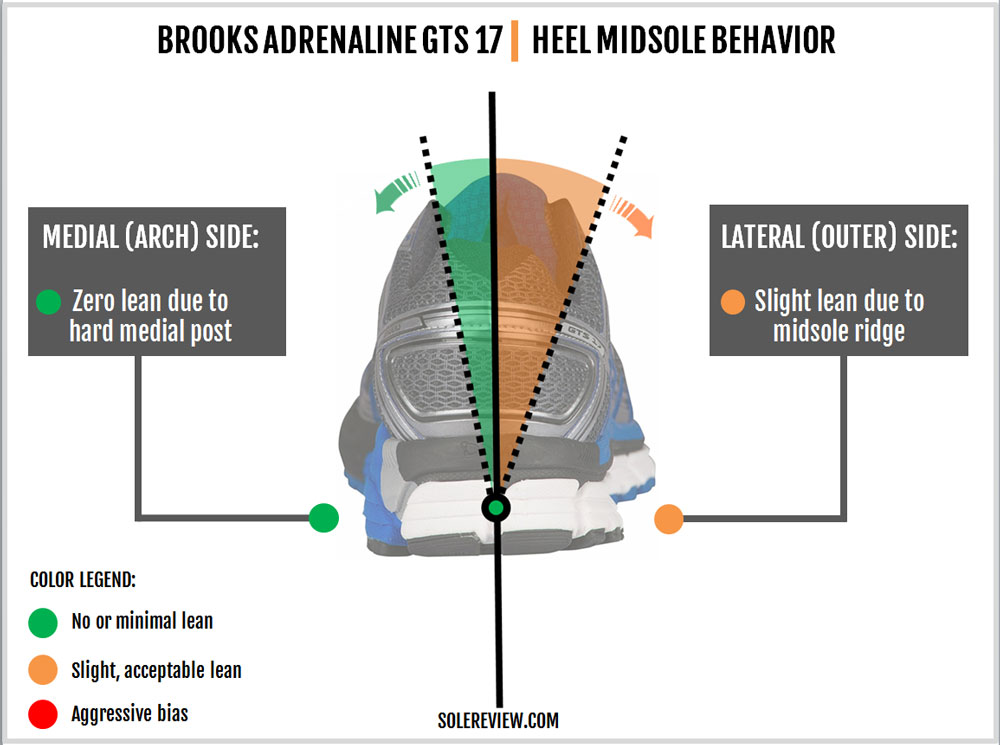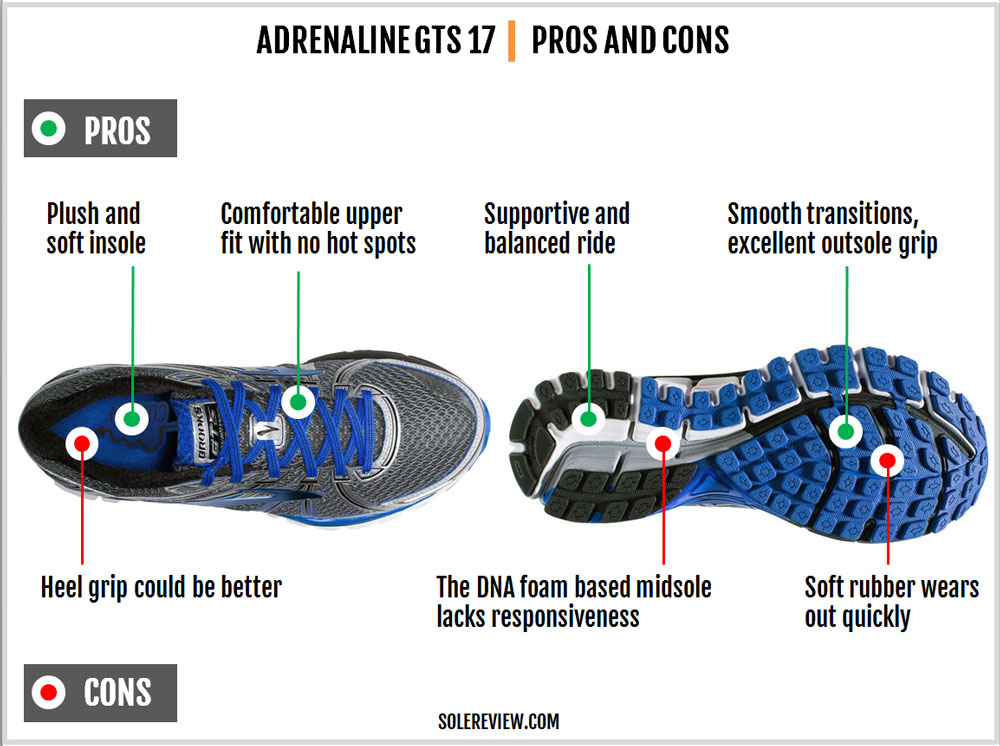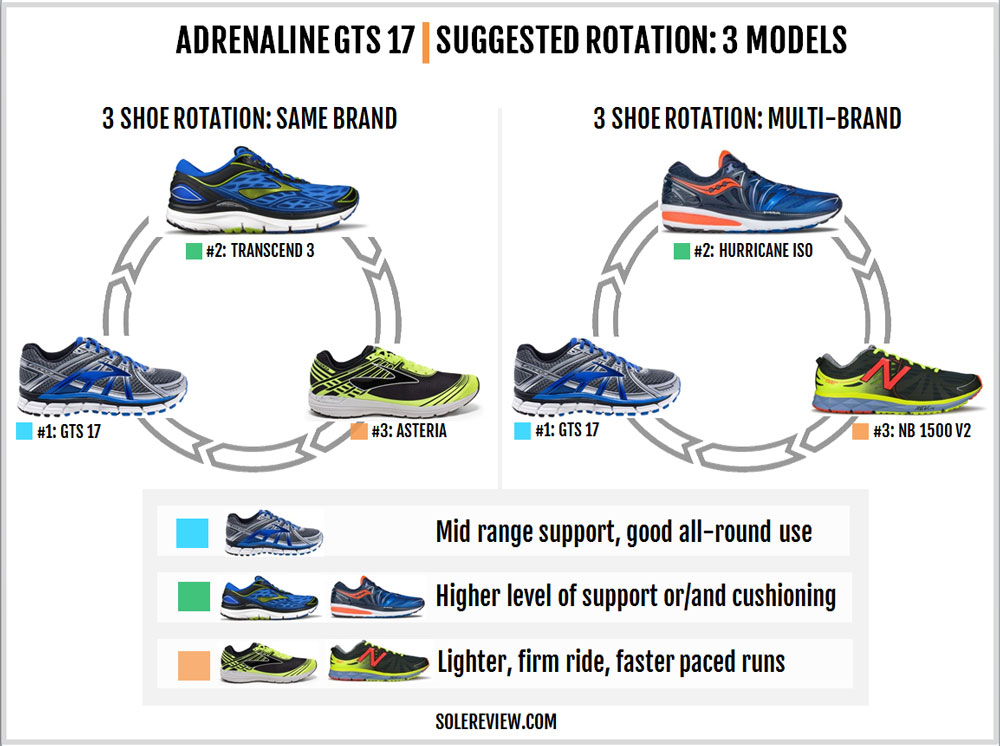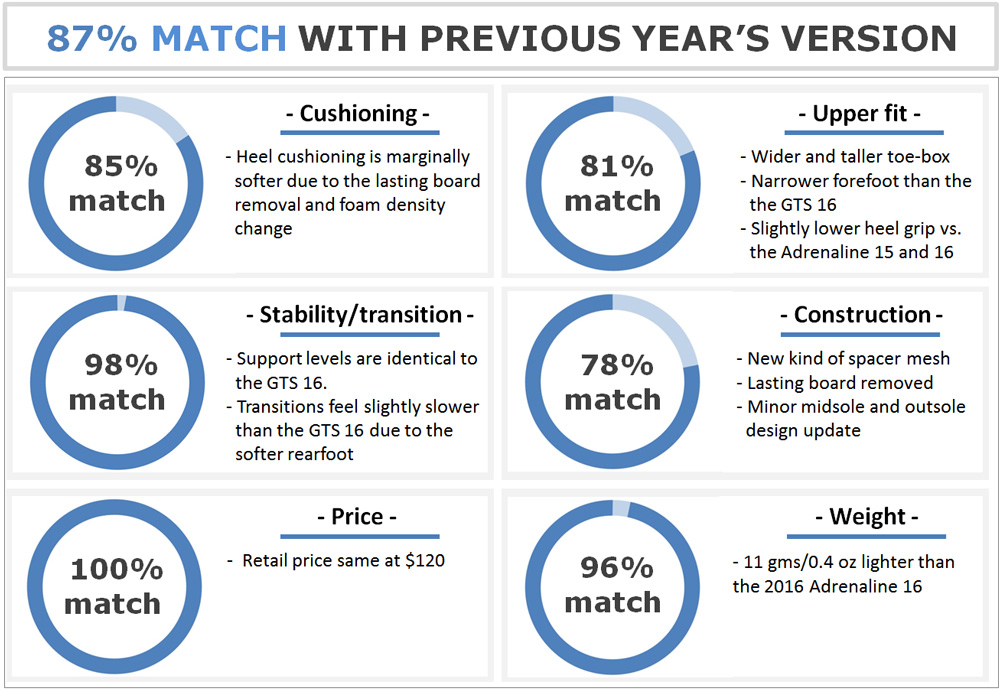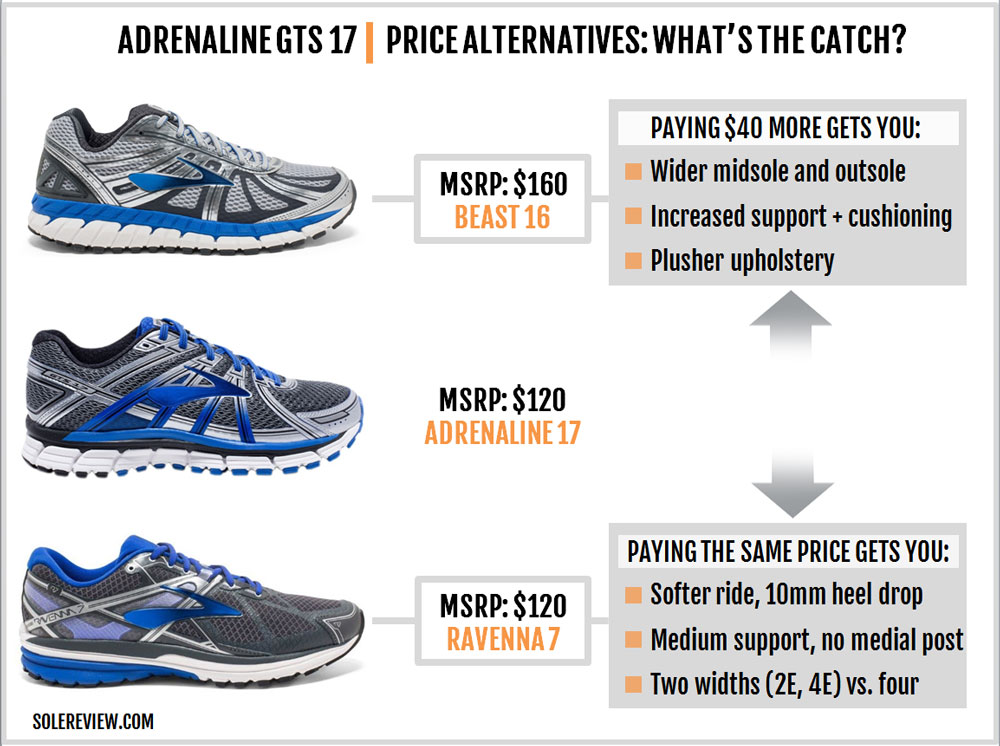INTRODUCTION
Ever since the swap to a foam based midsole, the Brooks Adrenaline GTS’s ride character has been more or less the same. Sure, there have been small updates made to the upper fit and the ride quality, but that hasn’t altered the GTS’s core persona.
The GTS 17 is no exception. The midsole is based on the same triple-density foam foundation used on the GTS 15 and 16, which means that the GTS 17 has a lot in common with the outgoing version. The Adrenaline retains its firm and supportive ride, which has been the hallmark of this long-continuing franchise.
That said, there are changes worth underscoring. There’s a difference in how the shoe fits and rides, a consequence of subtle tweaks made to the midsole and upper design.
In solereview’s opinion, the upper change is definitely a positive. As for the midsole, whether you see it as good or bad really depends on your personal preference.
The mid-weight support shoe club has many longstanding members. The Adrenaline GTS 17, as the suffix implies, has been around for seventeen years. Giving it company are familiar names like the Nike Structure 20 and Mizuno Inspire 13, shoes with a history spanning longer than a decade.
The Asics GT 2000 4 might sound like a four-year-old model, but remember that the GT 2000 is nothing more than a rehashed version of the GT 2160 series. A few newcomers such as the adidas Sequence 9 and the Skechers GoRun Forza complement the pack with their distinct design approach.
For example, the Skechers Forza flips conventional wisdom on its head. Instead of a firmer medial and softer lateral side, it does quite the opposite. The lateral side is firmer than the medial side, resulting in an entirely different ‘support’ experience.
On the other hand, the Sequence 9 uses the responsive Boost midsole without a medial post. This helps produce a novel ride character.
Shoes like the Asics GT 2000 adopt the tried-and-tested route, delivering a soft ride with a lateral midsole bias. The Mizuno Inspire 13 is nearly neutral, and that’s how it has been as long as we can remember.
The Adrenaline GTS 17 does nothing unconventional. Regardless of the tri-density midsole, the overall midsole has a firm and balanced ride.
DESIGN AND MATERIALS
Recently, we’ve seen the Brooks Ghost 9 – one of Adrenaline’s neutral cousins – switch to an engineered mesh for its upper. The Adrenaline GTS 17 refuses to take a leaf out of that playbook and instead sticks to a regular spacer mesh.
Except for the stray strip of a different material near the midfoot, the entire outer upper is constructed using spacer mesh. Structures made of laminated urethane cover the midfoot and parts of the heel, while the toe-bumper and the heel window use stitching.
Brooks uppers have always had a premium look and feel to them. That tradition is kept up by the GTS 17’s molded midfoot strips which add visual depth. Smaller details such as the tongue top label and the reflective heel strip are a nice touch.
Like the GTS 15 and 16, the tongue has no sleeve. That isn’t something to worry about, though. A unique Brooks feature in the form of a side tongue loop prevents the tongue from sliding. The slightly elastic flat laces are the same type used on the previous GTS version.
There are changes made to the heel collar lining. The past three GTS models had a dual-fabric collar design, meaning that there were two different fabrics used for the heel lining. The GTS 17 changes the lining to a single fabric type, an update which influences the upper fit.
The toe-bumper reverts to a traditionally designed stitched component, similar to what was used on the GTS 15. The Adrenaline 16 had a fused strip running over the forefoot, and that’s no more. Like the heel redesign, the reworked toe-bumper has a say in how the GTS 16’s upper fits.
Inside, the medial midfoot is reinforced with a fabric backer. The midfoot also features a synthetic panel on the outside, which reminds us of a material which Asics used a few years ago. The difference is that the GTS 17’s synthetic isn’t stretchable like the one on the Kayano.
In a way, a lot of the GTS 17’s upper design choices seem to be inspired by the GTS 15 format than the 16.
Although Brooks is one of the few brands which updates the entire shoe every year (vs. an upper only change for most brands), that doesn’t necessarily lead to drastic changes.
The GTS 17 has a 12 mm heel drop and triple-density foam midsole which appears nearly identical to the GTS 16. The medial midsole has three different kinds of foams; there’s the unmissable medial post which is the firmest of the three. The forefoot midsole has a relatively softer foam, and a thin strip of gray foam separates the medial post from the softer lateral (outer) foam.
This is another area where the GTS 17 feels closer to the 15. The midsole is slightly softer, and that’s not just due to the foam density change. The last year (and the year before), the GTS had a cellulose board under the insole.
The GTS 17 does not have that board. The lasting is all foam; that dials down the firmness factor by a notch or so. We believe that the early GTS 17 salesman samples came fitted with the board, but it was removed during final production.
Like the rest of the shoe, the outsole is completely redesigned. That has little effect on the layout, which stays nearly identical to the GTS 16. Except for the smaller rubber lugs under the forefoot and other minor tweaks, the rest of the outsole stays the same.
Outsole traction has always been excellent for Brooks outsoles; the durability less so. This has been the trade-off in most Brooks running shoes. The rubber sticks extremely well on most surfaces and under most conditions. In return, the outsole has a lower lifespan than competing non-Brooks shoes.
The Adrenaline GTS 17’s outsole lifespan will be similar to other models (Glycerin, Ghost) in the Brooks line-up. The softer blown rubber in the front is likely to see wear and tear faster than the harder heel rubber. For most runners, the forefoot shredding should happen on the medial side first.
The upper has excellent structural integrity, so you should have no areas to be concerned about.
UPPER FIT AND FEEL
There’s nothing in particular to report about the GTS 17’s midfoot fit. It feels the same as the 15 and 16; the synthetic panels and the padded tongue deliver a combination of comfort and support. Thanks to the side-loop, tongue slide stays in check.
Changes are made to the heel and toe-box. The heel collar now only uses a single fabric lining, so there’s a sense of slightly lower grip. Nothing to be worried about, just that it feels less grippy when compared to the GTS 14, 15 and 16. And as always, the heel fit isn’t always the product of the rearfoot alone, but the toe-area too.
The toe-box is taller and wider than the 16. The stitched-on bumper increases vertical space vs. the narrow strip design of the 16. The narrow strip also had the tendency to restrict sideways movement, and the stitched bumper corrects that. As a result, you’re bound to notice increased toe-box room and decreased heel grip if you’re moving up from the GTS 16.
On the other hand, if your last Adrenaline was version 15, then the 17’s toe-box will feel like a familiar place for your toes.
While the toe-box is wider than the 16, it comes with a caveat. The forefoot – the section between the toe-box and the midfoot – is narrower than the 16. There’s increased layering on both sides of the forefoot, which makes the 17 fit narrower than the 16.
For the umpteenth time, the GTS 17 shares another trait with the GTS 15. The Adrenaline 15 also had a similar design which led to a snug forefoot fit.
RIDE QUALITY AND BEHAVIOR
The GTS 17 is softer than the 16 due to the absence of the lasting board, but that’s being expressed purely in relative terms. When compared to the benchmarks of the running shoe universe, the overall ride quality is firm.
One of the reasons why the GTS feels so balanced (and firm) is that the three different foams used do not have wildly varying levels of density. This means that be it the lateral side or the forefoot, the foam tries to keep up with the hard medial post.
That means that the entire midsole is a firm base. The GTS used to be slightly soft until the version 14 when the midsole had a Gel insert inside. Any softness you feel is entirely because of the thick insole in contact with your foot.
The GTS 17 is not responsive. No matter what Brooks says about the Adrenaline’s DNA midsole, the latter feels like ordinary foam.
There are exceptions like the softer Transcend, but there’s no spring-back action with the GTS. Any responsiveness the Adrenaline ever had ended with the DNA gel based GTS 14.
Like all shoes with a medial post, the inner midsole is harder than the rest. Having pointed that out, the Adrenaline GTS 17 does a great job of balancing the foam densities on both sides.
There is a minor amount of lean towards the outer side, but nothing more than any other shoe would have. Overall, the GTS 17 performs well as a support shoe – the firm midsole makes sure of that.
The GTS 17 feels less ‘faster’ than both the GTS 15 and 16. That’s due to the lack of the cellulose board below the insole, where there’s now only a layer of foam.
PROS AND CONS
The GTS 17’s triple density midsole is supportive, and the upper fits well – for the most part. Being a Brooks shoe, the materials have a premium look and feel for its price. The sticky rubber used in the outsole grips well on most surfaces.
The GTS could do a better job at adding more character to its ride quality. The all-foam midsole feels flat and unresponsive, saved only by the excellent insole used over it.
While the DNA foam material has proven to be mildly responsive on softer models like the Transcend, its firm avatar used on the GTS is not responsive.
RECOMMENDED ROTATION
Though Brooks lists the Transcend 3 as a stability shoe, solereview views the Transcend as a supportive neutral shoe. Regardless of the positioning, the Transcend is well cushioned and serves well in rotation to the GTS. You get a differentiated (and softer) ride while reaping the benefits of the supportive midsole with a planted feel.
The Asteria is Brooks’ answer to models such as the New Balance 1500 V2 – a lightweight racer with a small medial post. The Asteria will work great for race days or speedy workouts on synthetic tracks.
Mind you, both the Transcend and Asteria fits narrower than the Adrenaline.
As far as non-Brooks shoes go, we suggest the Saucony Hurricane as a cushioned rotation to the GTS, and the ever-green New Balance 1500 V2 as the lightweight alternative.
SUMMARY
There are only three updates worth highlighting. The rearfoot is marginally softer due to the removal of the Texon board and a change in foam density, the toe-box is wider and taller, and the forefoot fits narrower than the GTS 16.
The byproduct of the board-free midsole is a change in transition quality. With the increase in softness, the GTS 17 feels a bit ‘slower’ than the GTS 16.
Thanks to the structural changes, the shoe weight has decreased by 0.4 ounces/11 grams over the GTS 16.
If the GTS doesn’t cut it for you from a stability perspective, then consider the Beast 16. It is Brook’s top tier stability shoe, with a huge medial post and a substantially wider midfoot footprint than the GTS 17. There’s more cushioning too, courtesy of the thicker insole and a high volume midsole.
The Beast 16 transitions to an all-foam based design, which is markedly different from the DNA gel based midsole of the Beast 14. So in a way, the Beast 16 shares a lot more in common with the GTS 17 than the Beast 14 did.
There aren’t lower priced support shoe alternatives below the GTS. The other two support shoes – the Ravenna 7 and the PureCadence 5 – are entirely different products without a traditional medial post.
Both the Ravenna and Cadence use a mild support feature which wraps around the rearfoot midsole. While the Ravenna has a softer ride than the GTS, the lightweight Cadence is somewhere between the Ravenna and Asteria.
The bottomline is, paying $40 over the Adrenaline GTS 17 gets you more support and cushioning in the form of the Beast 16. Pay the same retail price as the Adrenaline, and you get two different kinds of ride experience.

